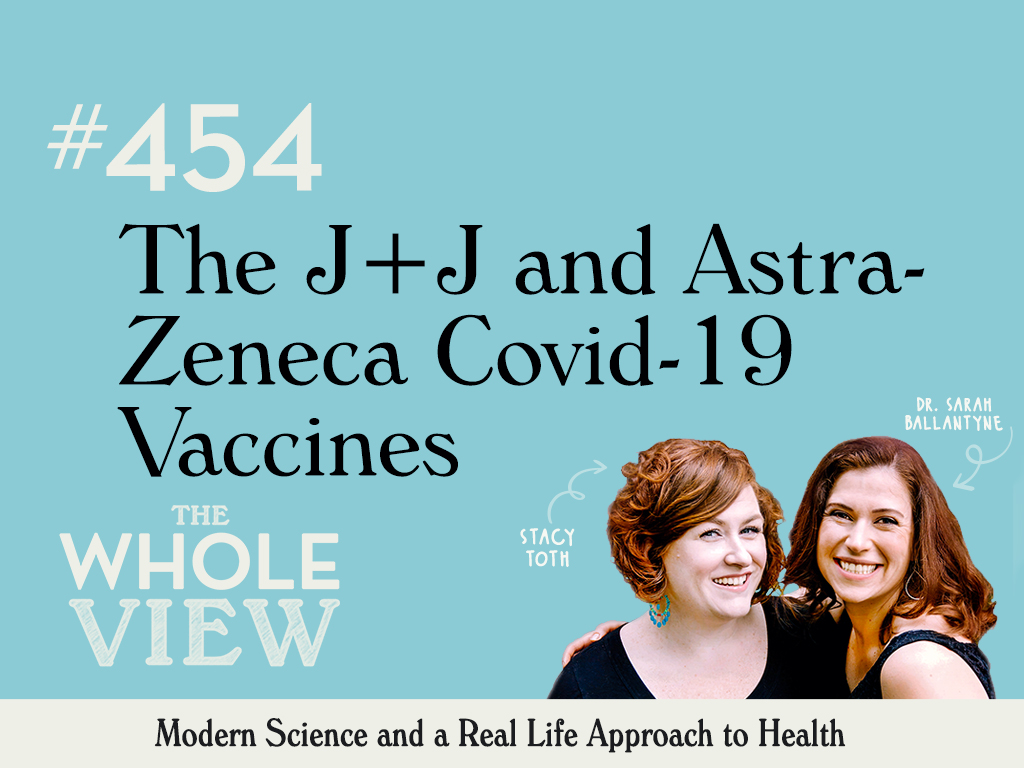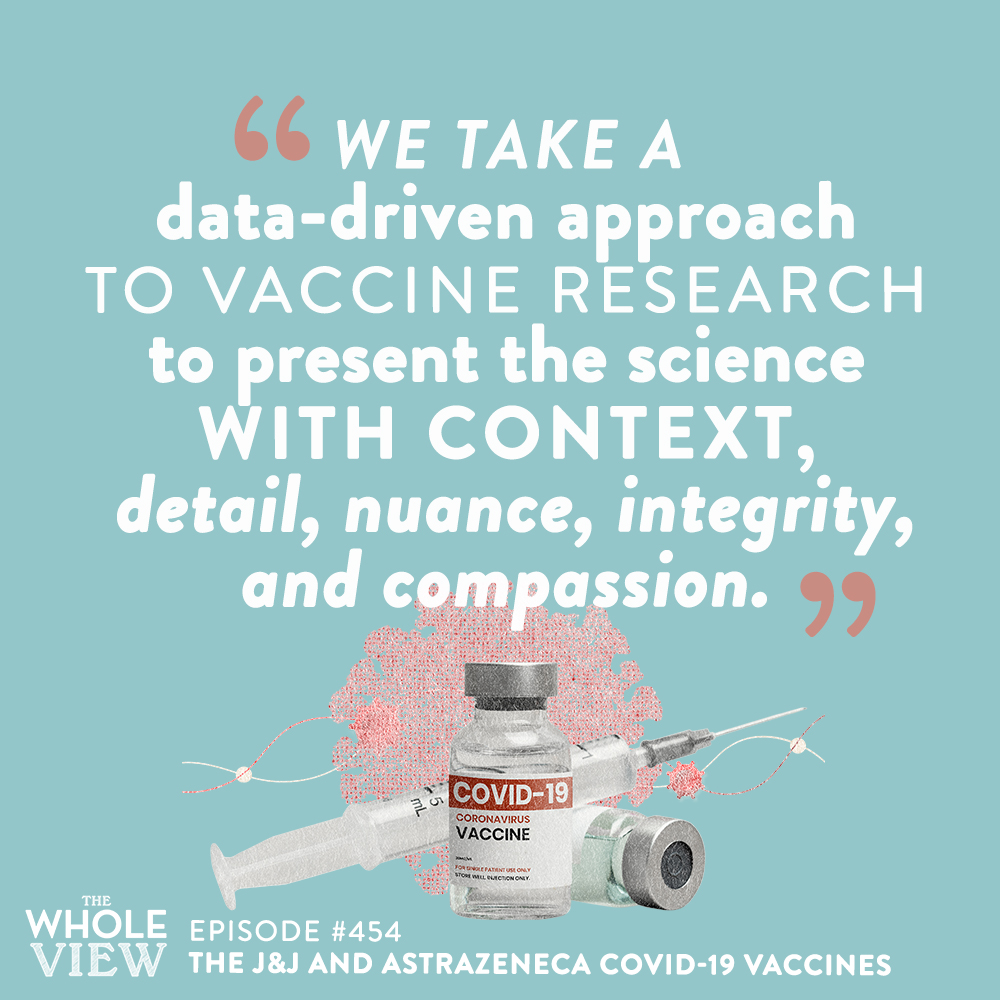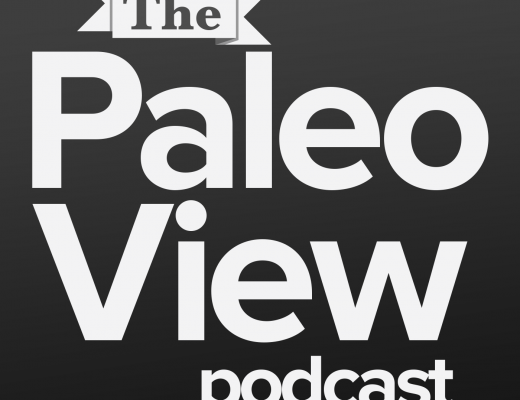
Welcome to episode 454 of The Whole View! This week, Stacy and Sarah look at the science behind the most recent J&J and AstraZeneca Covid-19 vaccines and compare them to the two previous vaccines. They also present as much science-backed information as possible to help listeners make informed decisions for what is right for them.
If you enjoy the show, please review it on iTunes!
The Whole View, Episode 454: J&J and AstraZeneca Covid-19 Vaccines
Welcome back to episode 454! (0:28)
This is the next part in a series of shows where Sarah and Stacy discuss the science behind the Covid-19 vaccines.
They strive to present you with all the information available to make an informed decision about whether receiving the vaccine is right for you.
Sarah plans to go through the show with the assumption that listeners have background/base knowledge about vaccines and how they work.
So if you have not yet listened to the previous shows in this series, Sarah highly recommends you do before listening to this episode.
Previous Covid-19 Shows
In episode #440, Sarah and Stacy examined the history of vaccines and the very real statistics on vaccine-induced injury. They also looked at the advances that led to mRNA vaccine technology and the inherent advantages of this platform.
Episode #441 explored the safety and efficacy data from the phase 2/3 clinical trials for both the Pfizer/BioNTech and the Moderna covid-19 vaccines.
In episodes #443 & #444, Sarah and Stacy answered listener FAQ. This included concerns about adverse events, including autoimmune disease, fertility, and antibody-enhanced infection. They also examined safety concerns for pregnancy and children and addressed common myths circulating on the internet.
Stacy and Sarah took a data-driven approach for all four episodes, presenting the science and facts with context, detail, nuance, integrity, compassion, and as objectively as possible.
Fact vs. Opinion on The Whole View
Stacy underlines that they are not here to convince you of a certain mindset or push a vaccine agenda in this show.
Although Stacy and Sarah may share their personal opinions on vaccines, they remind the audience that their opinions are just that – opinions. And what’s right for them might not be right for you.
They strive to take this same scientific approach today and next week with the J&J and AstraZeneca Covid-19 vaccines. (Yes! You’re getting two more vaccine shows!)
Stacy also reminds listeners of Sarah’s credentials and that she had a Ph.D. in research science. Like the other shows, they will address the rumors, concerns, and myths.
It’s critical to walk through the facts first. And remember- facts don’t have opinions. Stacy and Sarah’s primary agenda is to give the data for you to interpret for yourself.
Adenovirus Vector Vaccines
J&J and AstraZeneca Covid-19 vaccines are both DNA vaccines that use an adenovirus vector. The concept is similar to the mRNA vaccines but not wholly the same. (5:20)
Sarah reminds the audience that to make proteins, DNA is first transcribed into mRNA, which is then translated into protein.
So, both J&J and AstraZeneca vaccines deliver instructions to make the full-length covid-19 spike protein.
Only slightly different from the instructions for the mRNA vaccines, which have a couple of mutations to stabilize the tertiary structure into what’s called the postfusion conformation and the transmembrane anchor added
Both adenovirus vaccines encode full-length spike protein without the postfusion conformation stabilization mutations (say that 5 times fast!) but still add the membrane anchor.
Sarah recommends this source for more information.
So, these work similarly to the Pfizer/BioNTech and Moderna mRNA vaccines.
However, J&J and AstraZeneca Covid-19 vaccines require two steps to make the spike protein instead of one. They also require a special delivery agent to get into the cell nucleus. That’s where adenoviruses kick in!
Adenovirus Vectors Research
There are about 50 years of research on adenovirus vectors as DNA delivery vectors. (8:48)
Adenoviruses are basically common cold viruses that can cause illnesses ranging from cold-like symptoms to bronchitis, gastroenteritis, and conjunctivitis.
They are non-enveloped DNA viruses that can’t alter our DNA because (unlike retroviruses such as HIV or lentiviruses) wild-type adenoviruses do not carry the enzymatic machinery necessary for integration into the host cell’s DNA.
Basically, they do not enter our cell’s DNA.
Adenoviruses deliver DNA that can enter the cell nucleus, are transcribed into mRNA, leaves the nucleus, and then translated into protein. That’s exactly what makes them good vaccine platforms for infectious diseases.
I used adenovirus vectors (Ad 5, the same used in the Russian sputnik V and China’s CanSino covid-19 vaccines) for gene therapy research during my Ph.D. and even have a patent using them!
Different Adenovirus Serotypes
There are at least 88 human adenovirus types. Most serotypes cause mild illness, although data links adenovirus serotype 7 with more severe illness. (12:25)
When used for gene therapy research or vaccines, research engineers them to be incapable of replicating and causing disease.
There are adenovirus vector vaccines already in use. The rabies vaccine our pets get and the Ebola vaccine.
One problem with using adenoviruses in vaccines is that people may already have antibodies to them, overwhelming them before they can do their assigned work.
Researchers get around that issue by using adenoviruses that humans are unlikely to have encountered before.
The AstraZeneca/Oxford vaccine uses the ChAdOx1 platform based on a modified version of a chimpanzee adenovirus (causes colds in chimps and nothing in humans).
The Johnson & Johnson & Janssen (J&J) vaccine uses a proprietary AdVac platform made up of recombinant human adenovirus (adv26).
It’s the same platform used in the company’s Ebola virus vaccine (approved in Europe) and its investigational Zika, RSV, and HIV vaccines.
Adjuvants in J&J and AstraZeneca Covid-19 Vaccines
Like the mRNA vaccines, J&J and AstraZeneca Covid-19 vaccines don’t require an adjuvant. (14:40)
Stacy and Sarah talked about adjuvants in-depth in previous episodes.
The viral vector itself helps to prime the immune system in a specific way to fight a virus- not generally the way aluminum-based adjuvants do. Then the real stimulant is the spike protein our cells make.
The interesting thing about viral vector DNA vaccines is that our bodies react to it the same way as if we were actually sick with the illness.
Therefore, we get the same immune benefits as natural illness, minus the coronavirus’s ability to manipulate the immune system and even more robust and durable immunity.
Stacy shares that she was very surprised at how clean they were when she reviewed the vaccine ingredients.
Sarah confirms this, saying newer vaccines (such as the recent ones for Covid) are missing many ingredients from early vaccines that cause many people to be hesitant about getting vaccinated.
Ingredients in J&J:
- Recombinant, replication-incompetent adenovirus type 26 expressing the SARS-CoV-2 spike protein
- Citric acid monohydrate and trisodium citrate dihydrate – pH buffering, both naturally found in citrus fruit
- Ethanol
- 2-hydroxypropyl-β-cyclodextrin (HBCD), cyclic oligosaccharide containing seven D-(+)-glucopyranose units that are widely used to improve the aqueous solubility of various compounds, especially those containing a phenyl group, toxicology studies show very safe
- Polysorbate-80, emulsifier, pretty safe option
- Sodium chloride (aka salt)
- Source for Reference
Both AstraZeneca and J&J Covid-19 vaccines have reported that their vaccines were well tolerated with no serious safety concerns.
However, there have been recent reports of blood clot issues, which Sarah and Stacy will cover.
J&J and AstraZeneca Covid-19 Vaccines Clinical Trial Results
Like the mRNA vaccines, scientists could develop them quickly because of the decades of research scientists built from. (22:50)
It’s the same technology used in rabies vaccines for our pets and the Ebola vaccine (the only widespread vaccine used in humans).
Johnson & Johnson
- One-shot (they are testing a 2-shot version test for efficacy increase)
- Stable at normal refrigerator temperatures, so cold-chain requirements are easier
- J&J Vaccine Fact Sheet
- FDA Fact Sheet for J&J
- Safety and Efficacy of Single Dose
- Efficacy against symptomatic disease 66.9%
- Vaccine efficacy was higher against severe–critical Covid-19 (76.7% and 85.4%)
- Prevented 100% of deaths from covid-19
- No observable differences in vaccine efficacy according to sex, race, or ethnic group
- Similar to mRNA vaccines, no red flags from a safety perspective came up — The incidence of serious adverse events balanced between the vaccine group and placebo.
AstraZeneca
- Two shots
- 62% effective against symptomatic disease
- 100% against severe disease, hospitalization, and death
- Again, no red flag from a safety perspective
- Source for Reference
What About Adverse Side Effects?
Stacy points out that the media always leads with the lowest number of something potentially problematic instead of leading with the bigger number, such as preventing 100% of deaths. (24:50)
Sarah adds that the risk of developing a treatable reaction isn’t the worst thing if the same treatment is keeping you from something way more serious – such as death.
Stacy shares that it’s not just the death toll, it’s the risk of future complications and the way the symptoms can linger for months- two things she has personally experienced after having Covid last spring.
She hates how the media is so ready to focus on the drama of the vaccine but completely skips over how much it’s actually doing to protect us despite those few risks.
AstraZeneca Not Approved In US
Sarah explains that AstraZeneca’s US trial is still ongoing and not yet approved for use. (34:00)
However, she points out that no “red flags” were presented during the clinical trials for either of these vaccines.
That’s important to put into context since both have shown complications when used in the community (which researchers expected, and Sarah explains why).
The delay in the AstraZeneca trial lasted nearly seven weeks in the fall due to an adverse reaction in a UK participant. This was later determined as unrelated to the vaccine.
The initial trial results in November puzzled many experts from all around the world:
- The company combined data from its Brazil and UK groups, even though they had different sample sizes and demographics.
- It also averaged the results of two different dosing regimens (one administered by mistake).
- Just 12% of participants in AstraZeneca’s UK and Brazil trials were over 55 (but one quarter will be in US trial)
Now, scientists hope that results from AstraZeneca’s US trial will clear up much of the world’s confusion.
According to a press release, key interim results of the trial, which included more than thirty thousand participants, and the data looked excellent.
The vaccine appeared to be 79% effective at preventing “symptomatic COVID-19.”
The press release said that no one given the vaccine in the trial became severely ill, hospitalized, or died due to COVID-19. Also, the study did not turn up any serious safety concerns.
They’ll likely apply for an EAU in the states in the next month or two.
Why The Pauses Were Important
The pause allowed the collection of more data to see how prevalent this adverse effect is. This way, they can find more cases, and the total was 15 out of about 8 million doses had this effect.
The pause gives researchers time to educate patients on what to look out for and doctors on what to test for and how to treat. Sarah stresses that this is so important!
Here’s some perspective:
- For one million J&J shots, researchers expect about 2 cases of TTP
- This contrasts with over 2,000 fewer deaths and 6,000 fewer Covid-related hospitalizations
It’s important to know that the agencies tasked with community monitoring are actually doing their job. This is how it’s supposed to work!
New stories have called this pause a bad thing, which has increased vaccine hesitancy. The media then inflamed the issue in an inaccurate and unhelpful way.
Yes, plenty of people way they want Moderna or Pfizer instead of J&J right now. However, it takes time to educate people. Journalists need to focus on how the system works the right way to protect us instead of increasing fear.
Just because AstraZeneca isn’t approved yet doesn’t mean it’s unsafe. It means researchers want to devote enough time to understand the data as much as possible.
Moderna, Pfizer, J&J and AstraZeneca Covid- 19 Vaccines
Sarah explains that it’s impossible to make an accurate comparison of efficacy between these trials. (47:10)
Tests performed at different times, in different countries, with some variants may have impacted results.
For example, the USA tested Moderna first, and now we see it undergoing testing elsewhere.
The USA and Germany originally tested Pfizer (before B.1.1.7 became dominant). It is now undergoing testing elsewhere.
Argentina, Brazil, Chile, Colombia, Mexico, Peru, South Africa, and the United States tested the J&J vaccines.
Brazil, South Africa, and the UK tested AstraZeneca initially. It is now running trials in the US, Japan, Russia, Kenya, and Latin America.
Also, many areas define “symptomatic reactions” often vary.
Sarah explains that to actually and accurately compare, we’d need a head-to-head trial with far fewer variables.
What About the Blood Clots?
Stacy decides now is the time to talk about the elephant in the room: the reported risk of blood clots from the J&J vaccine. (52:45)
Sarah explains that this is nowhere near clot risk from birth control pills (some many women take regularly), which is 1:1000.
Also, it isn’t a good comparison. “Run-of-the-mill” embolisms or thrombosis are easily treated. However, large ischemic stroke or myocardial infarctions, pulmonary embolism are more serious.
The rates of these types of blood clots after the vaccines are about what you’d expect in the population normally.
However, this rare adverse event following J&J and AstraZeneca Covid-19 vaccines is NOT run-of-the-mill.
- https://www.bmj.com/content/372/bmj.n774
- Cerebral venous thrombosis and portal vein thrombosis risk is 10x higher after covid-19 than after AstraZeneca vaccine
- https://www.bmj.com/content/373/bmj.n931
Immune Thrombotic Thrombocytopenia (ITT)
Sarah underlines that calling this side effect “blood clots” isn’t entirely accurate. What’s actually happening ITT- an autoimmune response.
Immune Thrombotic Thrombocytopenia (ITT) is blood clotting at the same time as low platelets. However, if treated properly and promptly, ITT is very treatable!
This is so important because the normal way you treat blood clots (blood thinners like heparin) can cause death by hemorrhage.
With ITT, mortality is high (~90%) if untreated. The median age of onset 40 years and, like most autoimmune diseases, has a 3:1 female-to-male ratio.
Stacy also reminds listeners that autoimmune diseases cannot be “caused” by something. Immune diseases are latent in the system until triggered, which is bound to happen at some point regardless.
Autoimmune suffers aren’t necessarily at higher risk. Some HLA risk alleles for other autoimmune diseases protect against TTP, and many don’t increase risk at all.
- GREAT REVIEW PAPER
- https://www.nejm.org/doi/full/10.1056/NEJMe2106315
- https://www.nejm.org/doi/full/10.1056/NEJMoa2104882
Importance of J&J and AstraZeneca Covid- 19 Vaccines
First, it’s cheaper to make, ship, and store. So, they can get to places that are really tough to get the mRNA vaccines to, like rural America and developing nations. (1:12:10)
Stacy and Sarah remind the audience that the pandemic isn’t over until the whole world is protected.
The high infection rates lead to the variants of concern, which we’ll talk a bit more about next week.
This virus mutates slowly, but it has so many opportunities to mutate because of high infection rates, including in the USA.
J&J is great for people who dislike needles, unhoused people, and people with schedules that make getting the second shot hard (e.g., truckers or flight attendants who travel a lot).
More References for J&J and AstraZeneca Covid-19 Vaccines
- Watanabe, Y. et al. (2021) Native-like SARS-CoV-2 Spike Glycoprotein Expressed by ChAdOx1 nCoV-19/AZD1222 Vaccine. ACS Central Science, See source here
- https://www.thelancet.com/journals/lancet/article/PIIS0140-6736(20)31604-4/fulltext
Final Thoughts
These vaccines are just more tools in our toolbox to get through this pandemic. (1:15:10)
Stacy and Sarah have dedicated the last 8 years to do this podcast to focus on everyone’s health, safety, and wellness.
Stacy adds that we often get so caught up in our own health, wellness, and safety that we forget part of what a vaccine does is protect others.
It’s easy to be fearful and hesitant because there’s so much to the science that an average person might not easily understand.
And the more the media talks about it from a negative perspective, the less confident people get to go and get something that might be lifesaving- not just for themselves but others around them.
Stacy takes a minute to talk about the difference between one mild/moderate complication right after the vaccine (heavier period) compared to more long-term complications from “long hauler syndrome” (brain fog, i.e., brain damage).
Stacy reminds listeners that Patreon is a great way to connect. So if you haven’t joined the family yet, be sure to pop over for bonus content like how Stacy and Sarah really feel about the topics they discuss.
Thanks so much for listening, and we’ll see you next week!





